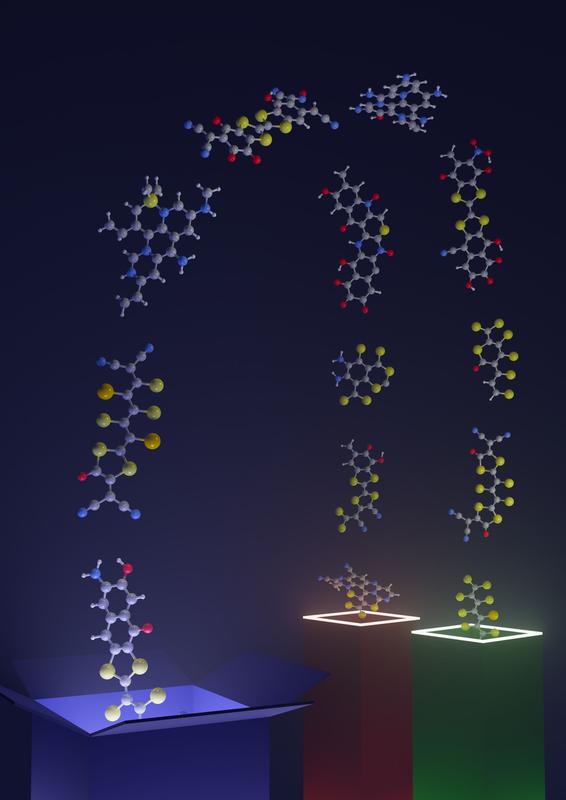Researchers find new method for targeted design of molecules

The image shows how molecules are created from a box. Based on artificial intelligence, these molecules can then be screened with other models, represented by the two adjacent boxes.
Graphic: Joe Gilkes
Thanks to artificial intelligence:
Engineering novel molecules and materials with specific properties can yield significant advances for industrial processes, drug discovery and optoelectronics. However, the search for novel molecules and materials is comparable to looking for a needle in a haystack, since the number of molecules in chemical space is of the unimaginable order of 10 to the power of 60. That is significantly more molecules than there are stars in the known universe. Scientists at Leipzig University and the University of Warwick have now succeeded in developing a new method that enables the targeted design of molecules and materials with specific properties.
They have now published their research findings in Nature Computational Science. The researchers combined various artificial intelligence methods in their experiments. First author, assistant professor Julia Westermayr from Leipzig University’s Wilhelm Ostwald Institute of Physical and Theoretical Chemistry explains: “One model learned to predict quantum chemical properties of molecules, while the other learned how those molecules are constructed.” She adds that the first model is necessary to enable a high degree of accuracy when screening properties, as conventional methods for calculating quantum mechanical properties are highly time-consuming and require considerable computational power. In an iterative process that involves repeating steps until a certain target is reached or certain criteria are met, the researchers then used both models to generate new molecules and filter them according to certain properties. “In each round, the design model learned how the best-suited molecules are constructed and thus specifically predicted molecules with optimised properties in the next round,” says Westermayr.
The basis for the study was laid by Rhyan Barrett during an internship at the University of Warwick in England, funded by the Artificial Intelligence and Augmented Intelligence for Automated Investigations for Scientific Discovery (AI4SD) network.
“We were particularly surprised that we were able to use artificial intelligence to find patterns in the data that led to optimised properties,” says Rhyan Barrett. Finally, the researchers managed to optimise multiple properties. This makes it possible to use the method to find Pareto-optimal solutions. A Pareto-optimal solution exists when the solution of several optimised properties has been found and the individual properties can only get better if another property gets worse in the process.
The method developed was used to design functional organic molecules relevant to optoelectronics. These novel, more efficient materials could be used in areas such as the solar energy industry, LED lighting, display technology, data storage, sensor technology and optical fibres in communications technology. The new method can also be transferred to other fields. Other potential areas of application include the development of active ingredients for new drugs with targeted, improved properties that are effective against specific diseases. Molecular design can also be used in environmental engineering to develop new processes for purifying waste water and air. In biotechnology, new biocatalysts and enzymes are developed based on the design of molecules with specific functions.
Wissenschaftliche Ansprechpartner:
Juniorprof. Dr. Julia Westermayr
Wilhelm-Ostwald-Institut für Physikalische und Theoretische Chemie der Universität Leipzig
Phone: +49 341 97-36404
EMail: julia.westermayr@uni-leipzig.de
Originalpublikation:
Publication in Nature Computational Science:
“High-throughput property-driven generative design of functional organic molecules”, doi.org/10.1038/s43588-022-00391-1
https://www.nature.com/articles/s43588-022-00391-1
Media Contact
All latest news from the category: Life Sciences and Chemistry
Articles and reports from the Life Sciences and chemistry area deal with applied and basic research into modern biology, chemistry and human medicine.
Valuable information can be found on a range of life sciences fields including bacteriology, biochemistry, bionics, bioinformatics, biophysics, biotechnology, genetics, geobotany, human biology, marine biology, microbiology, molecular biology, cellular biology, zoology, bioinorganic chemistry, microchemistry and environmental chemistry.
Newest articles
Faster, more energy-efficient way to manufacture an industrially important chemical
Zirconium combined with silicon nitride enhances the conversion of propane — present in natural gas — needed to create in-demand plastic, polypropylene. Polypropylene is a common type of plastic found…

Energy planning in Ghana as a role model for the world
Improving the resilience of energy systems in the Global South. What criteria should we use to better plan for resilient energy systems? How do socio-economic, technical and climate change related…

Artificial blood vessels could improve heart bypass outcomes
Artificial blood vessels could improve heart bypass outcomes. 3D-printed blood vessels, which closely mimic the properties of human veins, could transform the treatment of cardiovascular diseases. Strong, flexible, gel-like tubes…




















